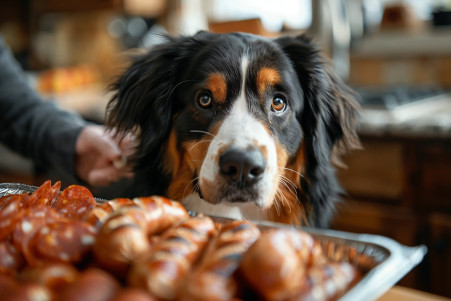Can Dogs Eat Meatballs? Risks and Safe Portions
5 June 2024 • Updated 5 June 2024

If you’ve ever wondered if you can give your dog a taste of your meatballs, there are a few things you should know. While dogs can eat plain meatballs in moderation, many meatball recipes include ingredients like onions, garlic, and spices that are harmful to dogs. Therefore, it’s best to avoid giving dogs meatballs that include these dangerous ingredients.
Even if you’re just giving your dog plain meatballs that don’t include any of the ingredients that are bad for dogs, they are high in fat and salt, which can cause health problems like pancreatitis if they are consumed in large amounts. To help you better understand the details of giving dogs meatballs, this article will take a closer look at veterinary nutritional studies that have looked at the ingredients in meatballs, the amount of meatballs that are safe for dogs to eat, and the impact of meatballs on a dog’s diet. It will also discuss the opinions of experts when it comes to giving dogs healthy, safe sources of protein as part of a nutritious diet.
Can dogs eat meatballs?
Dangerous Ingredients in Meatballs: What to Look Out For
Onions and garlic are poisonous to dogs and can lead to anemia and organ damage, so you should not give your dog meatballs that contain these ingredients. According to Modern Vet, if you give your dog a meatball that has onion or garlic in it, your dog will likely get sick. Meanwhile, the high levels of salt and fat found in store-bought or processed meatballs can cause digestive problems such as pancreatitis, and obesity in dogs. Processed meatballs are not a healthy option because they contain high levels of sodium, fat, fillers, preservatives, and additives that can be harmful to your dog.
In addition, some spices, including nutmeg, can be toxic to dogs and should be avoided in meatball recipes. Meanwhile, raw or undercooked meatballs can lead to bacterial infections, such as salmonella, if they aren’t handled and cooked properly, which can lead to vomiting, diarrhea, and dehydration that requires veterinary care.
Meanwhile, sauces or toppings, such as tomato sauce, can be problematic because they may contain ingredients like garlic salt. Even cheese toppings may be problematic if dogs consume too much dairy. This is why it’s important to make sure you know what all of the ingredients in a meatball are to avoid accidental toxicity. The best option is to make meatballs at home using lean meats and ingredients that are safe for dogs.
Homemade Meatball Recipes for Dogs: Healthy and Safe Choices
Homemade meatballs made with lean meats such as ground beef, turkey, or chicken can be a healthy and safe option for dogs. For example, the Meatball Dog Treat Recipe from Buddy V Foods suggests a recipe that includes lean ground beef, egg, Parmesan cheese, breadcrumbs, spinach, and carrots to make a healthy meatball for dogs.
Toxic ingredients like onions, garlic, and high levels of salt should be avoided in recipes, while dog-safe vegetables, grains, and herbs can be included. For example, the Homemade Meatballs for Dogs recipe suggests a recipe that includes lean ground beef, egg, cheddar cheese, breadcrumbs, and carrots to make a healthy and well-rounded meatball. Baking meatballs at the right temperature and allowing them to cool before serving can help ensure that they are safe for dogs to eat.
Homemade meatballs can be a good source of lean protein, fiber, and other nutrients when made with the right ingredients, as shown in the Dog-friendly Meatballs recipe. Meanwhile, Pook's Pantry offers a chicken meatball recipe that includes ground chicken, rolled oats, egg, parsley, carrots, and yogurt, which is a nutrient-rich option for dogs.
Watch Out for Portion Sizes and Overfeeding
In addition to the potential risks of the ingredients used in meatballs, it’s important to note that even when made with dog-safe ingredients, meatballs are high in fat and calories. Hepper notes that overfeeding meatballs can lead to obesity, pancreatitis, and other gastrointestinal issues in dogs.
If your dog has eaten too many meatballs, symptoms to watch out for include vomiting, diarrhea, lethargy, and abdominal pain. Pet Honesty says that if your dog has consumed toxic ingredients like onions or garlic, you may need to induce vomiting and take them to the vet immediately.
The right portion size for your dog will depend on their size and activity level. It’s important to feed meatballs, even homemade ones, in moderation to keep your dog safe and healthy. While meatballs can be an occasional treat with the right care, it’s important to make sure you’re not overfeeding your dog.
Trying Out Healthier Protein Options: Turkey and Chicken Meatballs
Turkey and chicken meatballs can be a healthier and lower-fat alternative to beef meatballs for dogs. According to The Dog People by Rover.com, turkey is a great lean protein for dogs, but turkey bones are not safe for dogs. The article explains that turkey meatballs, which are made without bones, can be a healthy option for dogs.
These protein sources are also less likely to cause digestive issues and allergies or sensitivities in dogs. Dogster explains that red meat, which includes beef, is a nutritional powerhouse for dogs, supplying them with essential amino acids, fats, vitamins and minerals. Turkey and chicken meatballs can offer these same nutrients in a leaner form.
If made with ingredients that are safe for dogs and without added fat or salt, turkey and chicken meatballs can be a healthy snack or addition to a dog's meal. Real.dog explains that turkey meatballs contain the five components of a dog's ancestral diet, which are muscle, organ, bone, seafood, and fiber, so they are an "amazing high value treat." Below, we will share some recipes and tips for making delicious and nutritious turkey or chicken meatballs so that you can add these leaner protein options to your dog's diet.
Cheese-Stuffed Meatballs: Health Risks and Benefits
Cheese can be a healthy and delicious addition to homemade dog meatballs, but it's important to use the right kinds and amounts. According to Bully Sticks Central, low-fat cheeses like cheddar, mozzarella, and cottage cheese are safe for dogs in small amounts, while high-fat cheeses like blue cheese or feta are not.
Feeding dogs too much cheese can cause digestive problems, obesity, and other health issues, so it's important to make sure that dogs only eat cheese in moderation. As noted in the Healthy Recipes Blog, the biggest issue with cheese-stuffed meatballs is that the cheese can leak out during cooking, so it's important to make sure that the meatballs are sealed properly.
Cheese can offer some health benefits to dogs, including protein and calcium, but it should only be a small part of a dog's diet. JustAnswer says that unless the meatballs contain a lot of cheese, a dog that eats them should be okay, although they may have some digestive upset. With the right care and portion sizes, cheese-stuffed meatballs can be a fun and tasty treat for dogs and their human family members.
Conclusion: How to Safely Share Meatballs With Your Pup
While plain, unseasoned meatballs can be a nice, occasional snack for dogs, it’s important to pay attention to the ingredients and portion sizes to keep them safe. The best option is to make your own meatballs at home with lean meats, dog-safe veggies, and by avoiding toxic ingredients like onions and garlic.
It’s also important to remember that dogs should only eat meatballs in moderation, as eating too many can lead to health problems like pancreatitis, obesity, and digestive issues. If you need help, a vet or professional dog nutritionist can help you make sure that your dog is eating a healthy, balanced diet. With the right care and recipes, meatballs can be a healthy and tasty snack that dogs and their human family members can enjoy together.


